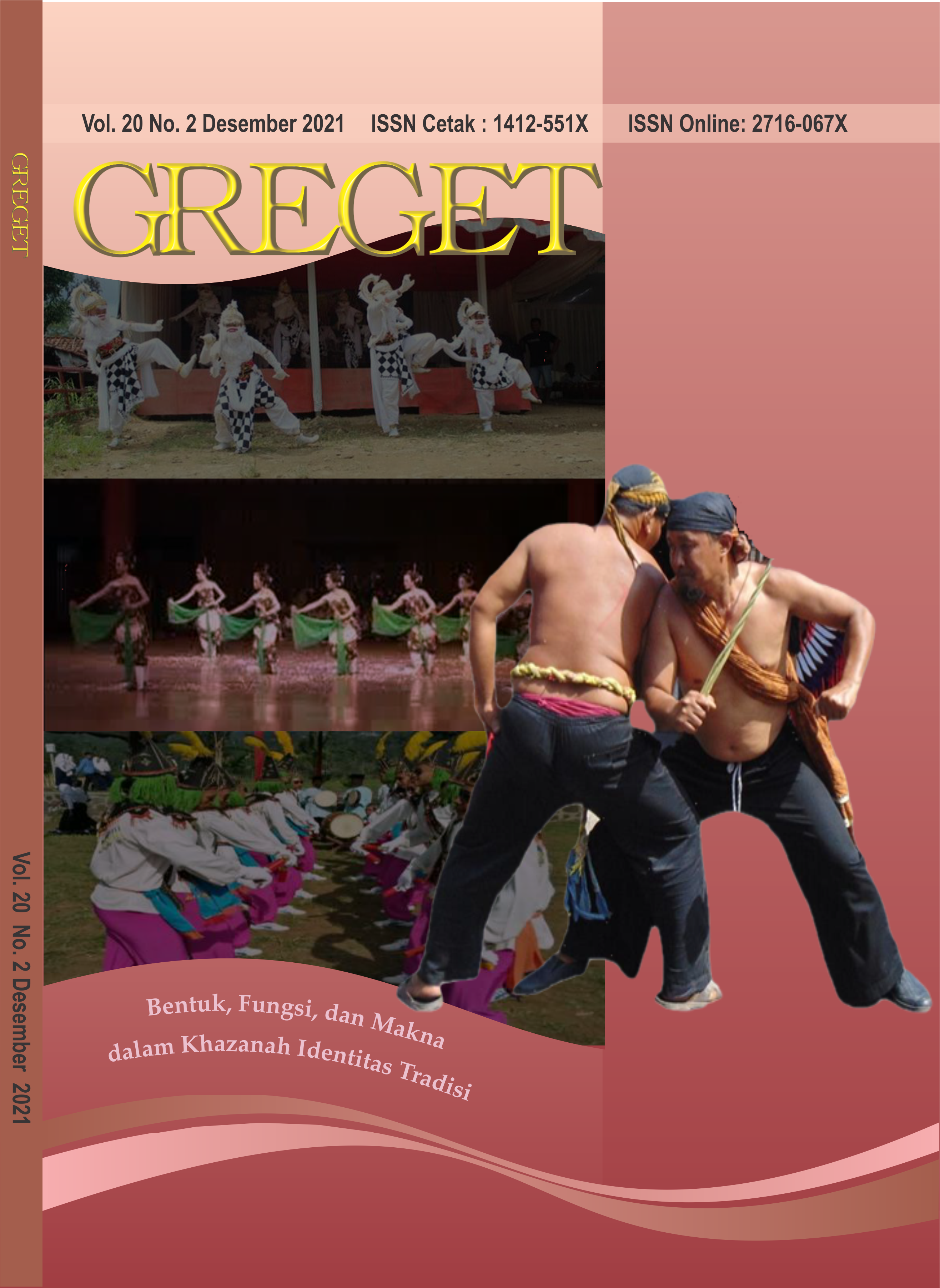MAKNA HOLISTIK TARI KETHÈK OGLÈNG KARYA GUNTUR TRI KUNCORO
Main Article Content
Abstract
This writing aims to reveal the meaning of the Kethek Ogleng dance by Guntur Tri Kuncoro by examining the problems formulated, namely the concept of the emergence of the Kethek Ogleng dance, the form of the Kethek Ogleng dance, the audience's response, and the meaning of the Kethek Ogleng dance by Guntur Tri Kuncoro. The analysis uses a holistic art criticism approach that is based on three main factors, namely genetics related to the concept of the appearance of the work, objective in the form of works and affective as a response or emotional response of the audience who are all sources of value flow. The form of writing is qualitative with data collection strategies through: observation, interviews and literature study. The results show that holistically the Kethèk Oglèng dance is meaningful as an entertainment medium, as a promotional event for cultural tourism, and is expected to be used as a means of student education and as an icon or identity of the City of Kediri.
Downloads
Article Details
Copyright
Authors who publish with GREGET agrees to the following terms:
- Authors retain copyright and grant the journal right of first publication with the work simultaneously licensed under a Creative Commons Attribution-ShareAlike 4.0 (CC BY-SA 4.0) that allows others to share the work with an acknowledgment of the work's authorship and initial publication in this journal.
- Authors are able to enter into separate, additional contractual arrangements for the non-exclusive distribution of the journal's published version of the work (e.g., post it to an institutional repository or publish it in a book), with an acknowledgment of its initial publication in this journal.
- Authors are permitted and encouraged to post their work online (e.g., in institutional repositories or on their website) prior to and during the submission process, as it can lead to productive exchanges, as well as earlier and greater citation of published work.
References
Catur Mustika Peni. 2017. “Tari Kethek Ogleng Sebagai Ekspresi Seni Komunitas Condro Wanoro, Desa Tokawi, Kecamatan Nawangan, Kabupaten Pacitan”. Skripsi. Program S-1 Tari Jurusan Tari Fakultas Seni Pertunjukan Institut Seni Indonesia (ISI) Surakarta. Sukarata: Institut Seni Indonesia (ISI).
Darwati, Iin, Nur Iswantara, dan Untung Muljono. 2021. Pembelajaran Langen Mandra Wanara Di Paguyuban Langen Mudha Mandra Budaya. Indonesian Journal Of Perfoming Arts Education, 01(1),23-31.
Evi Nailis Sa’adah. 2018. “Perkembangan Bentuk Seni Pertunjukan Kethek Ogleng di Desa Mojoroto Kota Kediri”. Skripsi Program S-1 Sastra Jurusan Seni dan Desain/Pend. Seni Tari dan Musik Fakultas Sastra Universitas Negeri Malang. Malang: Universitas Negeri Malang.
Hadi, Sumandiyo. 2003. Aspek-Aspek Dasar Koreografi Kelompok. Yogyakarta: eLKALPHI
. 2012. Koreografi. (Bentuk-Teknik–Isi). Yogyakarta: Cipta Media bekerjasama dengan Jurusan Tari Fakultas Seni Pertunjukan ISI Yogyakarta.
Hauser, Arnold, 1982 The Sociology of Art. London: The University Of Chicago Press Chicago and London.
Katarina Indah Sulastuti. 1996. “Kritik Holistik Tari Karonsih Karya S. Maridi” Skripsi Jurusan Tari Sekolah Tinggi Seni Indonesia. Surakarta: STSI Surakarta.
Margana, Agus Hari Wibowo. 2015. Aplikasi Ikon Kethek Ogleng Pada Kerajinan Lokal Untuk Mendukung Pengembangan Cenderamata Wisata Khas Kabupaten Wonogiri. Cakra Wisata, Vol 16 Jilid 2 Tahun 2015, 23-35
Maryono. 2011. Penulisan kualitatif Seni Pertunjukan. Surakarta: ISI Press.
. 2015. Analisa Tari. Surakarta: ISI Press.
M.D, Slamet. 2016. Melihat Tari. Karanganyar: Citra Sains.
Murgiyanto, Sal. 1983. Koreografi (Pengetahuan Dasar Komposisi Tari.
Prabhawati Adhiningasih, 2018. Kajian Opera Tari Jawa Langen Mandra Wanara Gaya Yogyakarta Dalam Perspektif Komunikasi Seni. Jember: FISIP Universitas Jenderal Soedirman.
Pudjasworo, B. (2014). Opera Tari Jawa Gaya Yogyakarta Langen Mandra Wanara: Sejarah, Tradisi, dan Bentuk Penyajiannya. Yogyakarta: Dinas Kebudayaan Daerah Istimewa Yogyakarta.
Soedarsono, 1986. “Pengantar Pengetahuan Tari” Yogyakarta: ASTI.
Soeharto, B., Supardjan, N., & Rejomulyo, R. (1999). Langen Mandra Wanara: Sebuah Opera Jawa. Jakarta: Yayasan Untuk Indonesia.
Sutopo,H.B. 1995. Kritik Seni Holistik sebagai Model Pendekatan Penulisan Kualitatif (Pidato Pengukuhan Guru Besar Ilmu Budaya pada Jurusan Senirupa, Fakultas Sastra Universitas Sebelas Maret. Surakarta: Sebelas Maret University Press,
. 2006. Metodologi Penulisan Kualitatif Dasar Teori dan Terapannya dalam Penulisan. Surakarta: Sebelas Maret University.
Yuliani, Elis. (2016). Bentuk dan Perkembangan Fungsi Serta Makna Kesenian Kethek Ogleng Di Desa Tokawi Kabupaten Pacitan. Universitas Gadjah Mada, 4 (2), 139–141.
